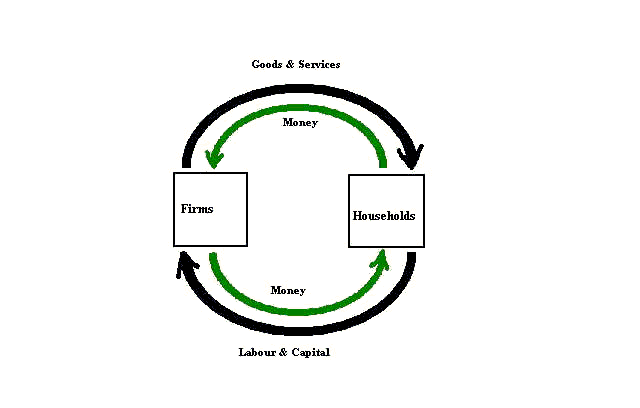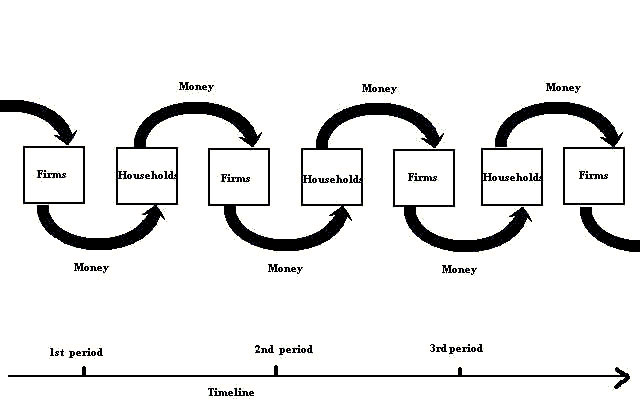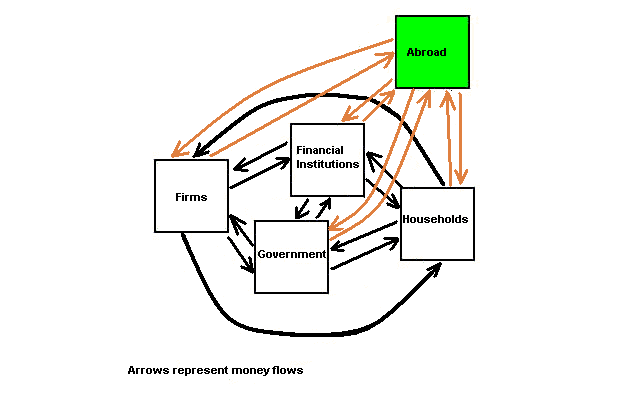|
|
Virtual money, descriptive explanation
If the short description of the concept of virtual money is
not enough for you, here is a more descriptive explanation (with illustrative
pictures).
Let’s start from the beginning i.e. from the Say’s Law (Jean
Baptiste Say was the French economists from the beginning
of XIXth century). According to this law:
The total amount of money in economy will be always equal to
the total amount of goods and services sold. In other words: "Supply creates its own demand" -
all money people have earned will be spent for manufactured goods and
services, even treasured money (i.e. saved for future) will be
eventually spent. Therefore the aggregate supply will be always equal
the aggregate demand. So, in a free market economy will be no such
phenomena like: oversupply, underconsumption, overproduction...
Here is the graphical illustration of this law (probably the
first illustration in every Macroeconomics book):
There is a closed circulation of
money and goods in the country economy:

Consumers (households) are earning money selling means of production
they have (i.e. labour, capital) and spend whole money on goods and
serviced sold by firms. Firms are earning money from selling
production, and spending the whole income on means
of production.
There are two problems wits Say’s law:
- First, it must have some flaw, because we can for time to
time observe overproduction, underconsumption, inflation and other
examples of situations, when supply of goods do not equals with supply
of money.
- Second, all contradctory explanations (like for example
explanation given by Keynes) are very weak and
are not explaining what is wrong with Say’s law.
So, If we want to understand economic crises, we first have to
understand why Say's law is not true.
Let’s add the time to our schema of money circulation in economy:
Circulation of money in economy
with timeline taken
into account

This schema of circulation looks better, because this time the stream
of money doesn’t look like snake eating his own tail.
We can see that the money does not have a quantum nature, and could
not be present in two places the same time. Money paid by firms (and
spent by households) doesn’t come from nowhere, but have to be earned
in antecedent period and the same is true for money spent by firms -
they have to be earned before they
are spent (even if that mean only one or two seconds before). Still
everything is okay - the supply equals the demand. But the economy is
stagnated
- there is no economic growth at all. Leett see what will happen, if we
have economic growth:
Circulation of money in economy
with timeline and
economic growth

This time the country’s national product (ex. gross national product,
GNP) increases - this is represented by increasing sizes of Households
and Firms squares.
But the volume of money earned in antecedent period (blue arrows) is too small to buy all the
goods and services produced in next period. Without some extra money,
economic growth will be damped down by the undersupply of money.
So, the extra money are needed (marked with red
arrows). Money that was not earned in antecedent period, and
are taken from nowhere - the virtual money.
The virtual money are
really a kind of magic trick (or accountancy trick). They have no real
value, they was not earned by selling some real good or service -
simply someone spends more money than he (or she or institution) really
has. Publicity (other
market players) accepts this extra spendings because they believe that
a player (I will call him debtor), who offers virtual money is solvent.
To be more precise: they believe that the future growth of income will
allow debtor to repay the debt (i.e. repay virtual money).
So, the virtual money is really the debt or the money borrowed
from the future. And have value only when we have economic growth. If
the rate of growth is not as high as the publicity (and debtors)
expected, the virtual money will became worthless.
Virtual money can be created using any kind of money:
- Can be created in bank, when the bank lends more money than
have deposits.
- Can be created by the government, when government prints
some fiat money or “paper money”.
- Can be created by monarch, when he mints coins that have
smaller percentage of precious metals than the monarch states.
- Can be created by a corporation, when firm sells bonds or
stocks.
- Can be created by the government selling government bonds.
- Can be created by households (ordinary people), when they
make debts using credit cards, or borrow money from banks, or take
mortgage credit.
- Can be created by the government, when government
revaluates national currency to make easier borrowing money from abroad
(and then repaying external debt).
etc.
Virtual money is only the small part of a particular “kind of
money” inside which virtual money was created (small part of fiat
money, small part of coin value, or stocks value). But when the crisis
comes and the publicity loses belief in virtual money, the whole kind
of money loses its value - its price falls. So, we can observe
a spectacular fall on market (an effect of the collapse of value):
- People go to the bank to take their money away and the bank
bankrupts.
- Price of fiat money falls and high inflation (or even
hyper-inflation) starts.
- We can observe a rapid fall on the stock market.
- The national currency rapidly depreciates.
To recapitulate:
1. There will be no economic growth without
some reasonable amount of virtual money - i.e. without some economic
stimulation.
2. Generally the reason for crisis is almost
always the previous growth. Or to be more precise, some unexpected
change in economic environment that slows down the rate of economic
growth (or starts the recession) and thus causes problems with repaying
debts taken in antecedent periods. There are many possible reasons for
this kind of changes in the economic environment:
- Some natural disaster
- Political changes in neighbouring state
- Change of economic policy in neighbouring state
- Important shift of trade routes
- Some changes in size of neighbouring economies or volumes
and directions of market flows (the South-Asia crisis of 1997 is a good
example here)
Of course, some times (especially in ancient times)
great natural disasters like flood, plague, or drought could be only
one
reason for
crisis, and these times we don’t need the concept of virtual money to
explain the crisis.
To simplify the whole pattern you should know that, generally
speaking, there are three most important ways to create virtual money:
- Expansive fiscal policy of
government - when economy is government-stimulated.
- Expansive actions of private firms
and financial institutions - when free market (laissez-faire
economy) dominates.
- Too highly revaluated national
currency (or “over-valued”) - when the poor country borrows
money from abroad.
But of course there are a hundred and one ways to create
virtual money. Recalling the first picture presented here - we can
complicate it a little, and add a few more players:
Money circulation in economy,
advanced schema

We have added the government, financial institutions (banks, stock
market, etc.) and the abroad. And marked the money flows between all
players. Virtual money can be created on any of these flows: ex.
between financial institutions and households (like credit cards). And
we can still add more players. Moreover, economy could be concurrently
stimulated with two or more types of virtual money. I hope this picture
clarifies, why the reasons for economic crises are so complicated.
Three elements that wasn’t mentioned here
1. First there are other methods to create
additional supply of money without using the virtual money.
If you recall the Fischer’s Equation
of Money, which states that the price level in economy and
the velocity of money are also important factors for the money supply:
The Fischer’s
Equation of Money:
P × Q = M × V
where:
P = the current price level (the implicit price
deflator of GNP)
Q = the current level of output (real GNP)
M = the current money supply
V = the velocity of money (the number of times each
banknote or coin is spent each year)
|
You can easy notice that the higher velocity of money
circulation also increases the money supply. This was the reason for
inventing: the credit, coins, banks, paper money, stock market,
derivates, internet transactions, etc.
2. Second - I skipped here the diffusion of
wealth from richer countries to poorer ones. This diffusion is one of
the most important reasons for economic crises and economic growth.
3. Third - one of consequences of the
virtual money is that no one economic equation is absolutely true,
because most
equations describe the static economy only.
Warsaw, 3 January 2004.
Clarification
Model of virtual money presented here is (using the words of Jack Cohen
and Ian Stewart) no more than “a lie for children” - i.e.
is a simplification needed to present this concept to unprepared reader.
I have assumed here that prices are not changing (see Fischer’s
Equation of Money above), because models with the changing prices are
much more complicated. A careful analyze of models with changing prices
proves that the economic growth without the virtual money is sometimes
possible,
and the reasons for virtual money are more sophisticated than I stated
here.
Remember: the virtual money are not the reason for economic growth, and
creating a stream of “unreal money” will not start the economic
prosperity. Virtual money are only a tool that makes possible to consume (or to be precise to
consume faster) the increase of productivity, which is an effect of
some real factor like
discovering new technologies, new mineral resources, or new countries
to conquer, etc.
Warsaw, 5 February 2004.
Cosmetic
corrections: March
2006.
Slawomir Dzieniszewski
|



